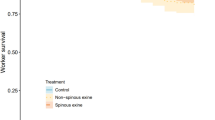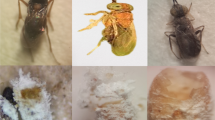Abstract
The effect of different prey mite species on development of the immature stages and on survival and oviposition of adult predator femalePhytoseiulus longipes Evans was studied.P. longipes completed its development onTetranychus pacificus McGregor,Oligonychus punicae (Hirst), andPanonychus citri (McGregor), but not onPetrobia harti (Ewing). Females oviposited while feeding onT. pacificus andO. punicae, but not onP. citri orP. harti. The highest percent survival was observed onT. pacificus, followed byO. punicae andP. citri. The longevity ofP. longipes onP. harti (vial arenas) and on pollen (leaf arenas) was the same as that on leaves with no food. The provision of 10% sucrose solution and clover honey doubled the longevity ofP. longipes females compared with no food.
Résumé
On a étudié l'effet de différentes espèces d'acariens comme proies dePhytoseiulus longipes Evans sur le développement des stades non mûrs et sur la survie et la ponte de la femelle de ce prédateur.P. longipes a eu un développement complet avecTetranychus pacificus McGregor,Oligonychus punicae (Hirst) etPanonychus citri (McGregor), mais non avecPetrobia harti (Ewing). Les femelles nourries avecT. pacificus etO. punicae pondent mais non avecP. citri ouP. harti. Le pourcentage de survie le plus élevé a été noté avecT. pacificus, suivi parO. punicae etP. citri. La longévité deP. longipes surP. harti (en flacon) et sur pollen (ou feuilles de haricot) a été la même que celle sur des feuilles sans aliment. L'addition d'une solution de sucrose à 10% et de miel de trèfle a doublé la longévité des femelles deP. longipes par rapport à celles ne disposant pas de nourriture.
Similar content being viewed by others
References
Ashibara, W., Hamamura, T. &Shinkaji, N. — 1978. Feeding, reproduction, and development ofPhytoseiulus persimilis Athias-Henriot [Acarina: Phytoseiidae] on various food substances.Bull. Fruit Tree Res. Stn., Japan, B2, 91–98.
Birch, L.C. — 1944. The effect of temperature and dryness on the survival of the eggs ofCalandra oryzae L. (small strain) andRhizopertha dominica Fab. [Coleoptera]. —Austr. J. Exper. Biol., 22, 265–269.
Chant, D.A. — 1961. An experiment in biological control ofTetranychus telarius (L.) [Acarina: Phytoseiidae] in a glasshouse using the predacious mitePhytoseiulus persimilis Athias-Henriot [Phytoseiidae]. —Can. Entomol., 93, 437–443.
De Moraes, G.J. &McMurtry, J.A. — 1981. Biology ofAmblyseius citrifolius (Denmark & Muma) [Acarina: Phytoseiidae]. —Hilgardia, 49, 1–29.
Flaherty, D.L. — 1967. The ecology and importance of spider mites on grapevine in the southern San Joaquin Valley with emphasis on the role ofMetaseiulus occidentalis (Nesbitt). —Ph. D. Thesis, Univ. of Calif. Berkeley.
Flaherty, D.L. &Huffaker, C.B. — 1970. Biological control of Pacific mites and Willamette mites in San Joaquin Valley vineyards. —Hilgardia, 40, 267–330.
Hoyt, S.C. — 1969. Integrated chemical control of insects and biological control of mites on apple in Washington. —J. Econ. Entomol., 62, 74–86.
Huffaker, C.B. &Kennet, C.E. — 1956. Experimental studies on predation: predation and cyclamen mite populations on strawberries in California. —Hilgardia, 26, 191–222.
McMurtry, J.A. — 1963. Diaspidine scale insects as prey for certain phytoseiid mites. In: Advances in Acarology. —Cornell Univ. Press, Ithaca, New York, 1, 151–154.
— — 1980. Biosystematics of three taxa in theAmblyseius finlandicus group from South Africa with comparative life history studies [Acarina: Phytoseiidae]. —Int. J. Acar., 6, 147–156.
McMurtry, J.A. &Scriven, G.T. — 1964. Studies on the feeding, reproduction, and development ofAmblyseius hibisci [Acarina: Phytoseiidae] on various food substances. —Ann. Entomol. Soc. Am., 57, 649–655.
— — 1965. Life-history studies ofAmblyseius limonicus, with comparative observations onAmblyseius hibisci [Acarina: Phytoseiidae]. —Ann. Entomol. Soc. Am., 58, 106–111.
— — 1966a. The influence of pollen and prey density on the number of prey consumed byAmblyseius hibisci [Acarina: Phytoseiidae]. —Ann. Entomol. Soc. Am., 59, 147–149.
McMurtry, J.A. &Scriven, G.T. — 1966b. Effects of artificial foods on reproduction and development of four species of phytoseiid mites. —Ann. Entomol. Soc. Am., 59, 267–269.
McMurtry, J.A., Huffaker, C.B. &Van de Vrie M. — 1970. Ecology of tetranychid mites and their natural enemies: A review. I. Tetranychid mites: their biological characters and the impact of spray practices. —Hilgardia, 40, 331–390.
McMurtry, J.A., Mahr, D.L. &Johnson H.G. — 1976. Geographic races in the predaceous mite,Amblyseius potentillae [Acarina: Phytoseiidae]. —Int. J. Acar., 2, 23–28.
Mellanby, K. — 1935. The evaporation of water from insects. —Biol. Rev. Cambridge Phil. Soc., 10, 317–333.
Mori, H. &Chant, D.A. — 1966. The influence of humidity on the activity ofPhytoseiulus persimilis Athias-Henriot and its preyTetranychus urticae (C.L. Koch) [Acarina: Phytoseiidae, Tetranychidae]. —Can. J. Zool., 44, 863–871.
Author information
Authors and Affiliations
Rights and permissions
About this article
Cite this article
Badii, M.H., McMurtry, J.A. Effect of different foods on development, reproduction and survival ofPhytoseiulus longipes [Acarina: Phytoseiidae] . Entomophaga 28, 161–166 (1983). https://doi.org/10.1007/BF02372140
Issue Date:
DOI: https://doi.org/10.1007/BF02372140




